Home > Highlighting JAPAN > Highlighting Japan APRIL 2011 > World Rushes to Japan's Aid
Highlighting JAPAN
COVER STORY: Pulling Together—Thank you for being at our side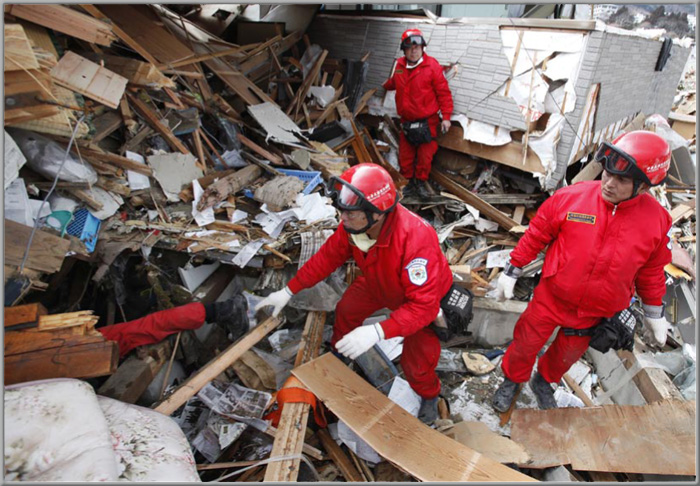
Caption: Members of a Taiwanese rescue team search for survivors in Ofunato, Iwate Prefecture, March 17.
Credit: AP/AFLO
World Rushes to Japan's Aid
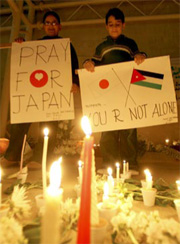
Jordanian boys attend a vigil outside the Japanese Embassy in Amman, March 20.
Credit: AP/AFLO
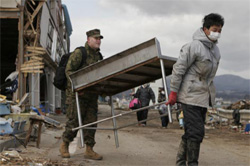
A U.S. Marine and a resident of Oshima island in Miyagi Prefecture carry a table from a building destroyed by the March 11 tsunami.
Credit: LANCE CORPORAL GARRY J. WELCH
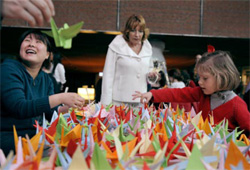
At a culture center in Bilbao, Spain, people help to fold 1,000 paper cranes in support of the earthquake disaster victims in Japan, March 26.
Credit: REUTERS/AFLO
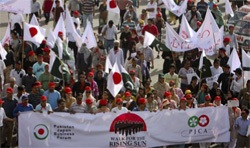
Pakistani families take part in a rally organized by the Pakistan-Japan Cultural Association, March 20.
Credit: AP/AFLO
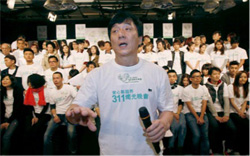
Actor Jackie Chan and scores of other artists attend a news conference in Hong Kong before a charity event in support of the earthquake disaster victims in Japan, March 24.
Credit: AP/AFLO
New Zealand's Minister of Foreign Affairs Murray McCully stated, "Japan and New Zealand are very close partners, and it is natural that we support each other in times of great adversity, as we saw with the Japanese response to the Christchurch earthquake."
President Barack Obama wrote the following in a letter to His Majesty The Emperor on March 24: "The devastation and loss of life caused by the catastrophic earthquake and tsunami that struck your nation on March 11 is heartbreaking, and our prayers are with you in this time of grief. ... I speak for all Americans in expressing admiration for the courage, strength, and determination with which the people of Japan are responding to this crisis. I have every confidence that Japan will rebound from this tragedy even stronger than before and set an example for other nations through your resilience."
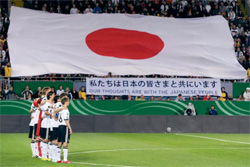
At the Fritz-Walter-Stadion in Kaiserslautern, players of the German national football team observe a minute's silence in memory of those who lost their lives to the earthquake disaster in Japan, March 26.
Credit: AFLO
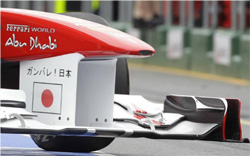
The front spoiler of the Ferrari Formula 1 car driven by Fernando Alonso of Spain at the Australian Grand Prix sports a Japanese flag and a phrase ("Fight on, Japan!"), March 25.
Credit: REUTERS/AFLO
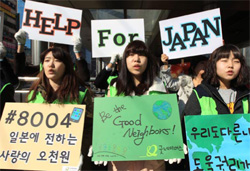
Members of a South Korean charity organization raise funds in downtown Seoul in aid of the victims of the earthquake disaster, March 17.
Credit: YONHAP/AFLO
President Sarkozy added that France, as a nation which itself has advanced energy technologies, is prepared to provide whatever further assistance Japan requires.
Standing with Japan
Ordinary people, too, have sent much aid and many messages to Japan in response to this disaster. There has been wide coverage in the national media of the kinds of aid given and, in addition, many Japanese have taken heart from things such as video messages posted on Internet video sites.
In Washington, D.C., the U.S. capital, a charity auction and fundraising activities have been conducted during the National Cherry Blossom Festival held from March 26. Hundreds of citizens also participated in the Stand with Japan Walk. The National Cherry Blossom Festival in Washington, D.C. started ninety-nine years ago, in 1912, when Tokyo gave 3,000 cherry trees as a symbol of friendship between Japan and the United States.
There is a custom in Japan of folding paper into the shape of a crane, making what's called orizuru. These paper cranes symbolize prayers for recovery from illness, long life and peace. People around the world are making paper cranes as symbols of their prayers for the victims and for rebuilding from the earthquake. Large numbers of flowers and paper cranes were left in front of the main gate of the Japanese Embassy in Moscow. Children from a Russian orphanage visited the embassy and presented a gift of a thousand paper cranes, symbolizing their hopes that the children in the disaster-stricken areas will recover quickly.
Also, through the Japan International Cooperation Agency (JICA), which provides support for developing countries, a variety of encouraging messages have been sent from more than 100 countries and regions, from the people that have come to Japan for training or received aid from Japan. In the Palestinian territory, the Gaza Strip, which even now is in a tense situation, fifty former JICA training participants gathered on March 21 to mourn the victims of the disaster in Japan.
Besides these, there are many other kinds of aid and messages continuously arriving in Japan. The Japanese people have accepted each one of these events with sincere gratitude.
 Noriyuki Shikata, director of Global Communications at the Prime Minister's Office of Japan Stay Informed
In the aftermath of the Great East Japan Earthquake, the Japanese government has made a concerted effort to release information promptly and with utmost transparency to all segments of the public and the international community. You can access this information in English at the URLs listed below. In addition, for regular updates about the latest news releases in English, follow me on Twitter: https://twitter.com/norishikata. Countermeasures for the Great East Japan Earthquake: http://www.kantei.go.jp/foreign/incident/ Prime Minister's Office Twitter page: http://twitter.com/JPN_PMO Prime Minister's Office Facebook page: http://www.facebook.com/Japan.PMO Press Conference by the Chief Cabinet Secretary on Internet TV (English interpretation): http://nettv.gov-online.go.jp/eng/ Press Conferences and Briefings: http://www.mofa.go.jp/j_info/visit/incidents/press/ |
© 2009 Cabinet Office, Government of Japan






